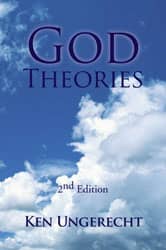Now Featured in the  Patheos Book Club
Patheos Book Club
God Theories
By Ken Ungerecht
Chapter Overview
Chapter 1 introduces the primary theme of the book which is the exploration of whether or not science can be used to support the concept of a Divine Presence as being something that has influence in the formation and functioning of our universe, the world we live in, and the life within that world. The author also points out that a very important reason for this exploration is the increasing influence of fundamental religious beliefs in formulating our public policy. He stresses that if we are going to allow this influence to continue, those beliefs need to have a stronger basis than blind faith and passion. The presence of some level of logic and reason must exist to provide them a more viable structure.
Chapters 2 through 5 provide brief and high level overviews of what we know about the three fundamental components of our universe, matter, energy, and consciousness. They also probe the possibility put forth by Neils Bohr and others that consciousness is an integral part of all matter and energy and not just of the life forms that we normally associate it with.
Chapter 6 reviews and outlines the fundamental precepts of the three generally accepted theories of origin of life on our planet, Creationism, Intelligent Design, and Classical Evolution. It also introduces a 4th, less commonly accepted theory, which hypothesizes that consciousness is an integral part of the process of the development of life from the beginning and which seeks to fill some of the gaps left by each of the other three. The author has chosen to label this theory Instinctively Directed to Consciously Driven Evolution.
Chapter 7 introduces a mathematical exercise designed to demonstrate our existence cannot simply be a product of chance as many would claim it is. It uses the fundamental ideas generated from this exercise to show that atheism is not a viable philosophy to explain the observable way in which our universe functions.
Chapter 8 lays out the mathematical exercise introduced in Chapter 7 in a scientifically accepted format to conclusively prove the following spiritually related ideas:
1. None of us could have possibly come into this world by chance. In other words Conscious Choice from outside the physical realm had to be a part of the process which determined how, where, and why we did come into this world.
2. The existence of the Essence of who we are cannot possibly depend upon the creation of a particular physical body. That would imply that this Essence must exist, both prior to the existence of any body that it does use, and then, following the demise of that body as well.
3. The classical theory of evolution cannot possibly be true. The basic concept of evolution itself has certainly been demonstrated far beyond any doubt to be a truth but God Theories clearly shows that some of the long cherished ideas describing that theory are, at some point, going to have to be modified.
Chapter 9 introduces additional evidence and speculations designed to support and further explain and expand upon the ideas proven in chapter 8.
Chapter 10 discusses the nature of beliefs, how we acquire them, the importance of being able to change them when that is deemed necessary, and the fundamental role they play in creating our experience.
Chapter 11 discusses the increasing influence that religious beliefs are playing in the political arena and the fundamental importance of maintaining the separation of church and state that is provided for in our constitution. It also talks about the efforts made by the proponents of Intelligent Design to introduce courses into the public schools to balance what they see as the atheistic teaching of evolution. The author points out that there is much validity in this argument. But he also emphasizes that if the concept of God and human spirituality are going to be a part of the school curriculum it must include a far broader set of ideas than simply those put forth by the Intelligent Designers. An outline of what these might include is also provided and discussed in the chapter.
Chapter 12 reviews the basic mandates of the 1st amendment in providing for the separation of church and state. It also reminds the reader, however, that this amendment also guarantees freedom in the search for truth and that the Intelligent Designers are right when they point out some of the shortcomings in the way that evolution is taught in our public schools. It also reiterates the argument, however, that if the concept of God is going to be taught in the public schools, and if it is going to pass muster with the 1st amendment, it must include far more than just those ideas put forth by the Intelligent Designers and the evolutionists.
1/16/2012 5:00:00 AM




